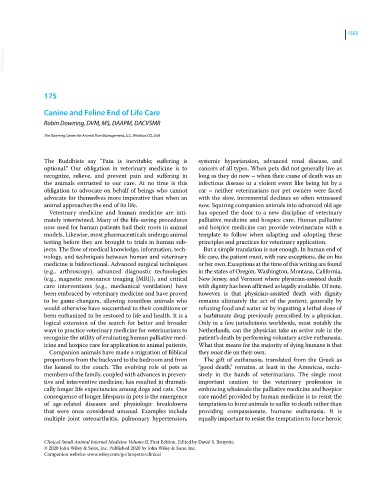Page 1617 - Clinical Small Animal Internal Medicine
P. 1617
1555
VetBooks.ir
175
Canine and Feline End of Life Care
Robin Downing, DVM, MS, DAAPM, DACVSMR
The Downing Center for Animal Pain Management, LLC, Windsor, CO, USA
The Buddhists say “Pain is inevitable; suffering is systemic hypertension, advanced renal disease, and
optional.” Our obligation in veterinary medicine is to cancers of all types. When pets did not generally live as
recognize, relieve, and prevent pain and suffering in long as they do now – when their cause of death was an
the animals entrusted to our care. At no time is this infectious disease or a violent event like being hit by a
obligation to advocate on behalf of beings who cannot car – neither veterinarians nor pet owners were faced
advocate for themselves more imperative than when an with the slow, incremental declines so often witnessed
animal approaches the end of its life. now. Squiring companion animals into advanced old age
Veterinary medicine and human medicine are inti- has opened the door to a new discipline of veterinary
mately intertwined. Many of the life‐saving procedures palliative medicine and hospice care. Human palliative
now used for human patients had their roots in animal and hospice medicine can provide veterinarians with a
models. Likewise, most pharmaceuticals undergo animal template to follow when adapting and adopting these
testing before they are brought to trials in human sub- principles and practices for veterinary application.
jects. The flow of medical knowledge, information, tech- But a simple translation is not enough. In human end of
nology, and techniques between human and veterinary life care, the patient must, with rare exceptions, die on his
medicine is bidirectional. Advanced surgical techniques or her own. Exceptions at the time of this writing are found
(e.g., arthroscopy), advanced diagnostic technologies in the states of Oregon, Washington, Montana, California,
(e.g., magnetic resonance imaging [MRI]), and critical New Jersey, and Vermont where physician‐assisted death
care interventions (e.g., mechanical ventilation) have with dignity has been affirmed as legally available. Of note,
been embraced by veterinary medicine and have proved however, is that physician‐assisted death with dignity
to be game‐changers, allowing countless animals who remains ultimately the act of the patient, generally by
would otherwise have succumbed to their conditions or refusing food and water or by ingesting a lethal dose of
been euthanized to be restored to life and health. It is a a barbiturate drug previously prescribed by a physician.
logical extension of the search for better and broader Only in a few jurisdictions worldwide, most notably the
ways to practice veterinary medicine for veterinarians to Netherlands, can the physician take an active role in the
recognize the utility of evaluating human palliative med- patient’s death by performing voluntary active euthanasia.
icine and hospice care for application to animal patients. What that means for the majority of dying humans is that
Companion animals have made a migration of Biblical they must die on their own.
proportions from the backyard to the bedroom and from The gift of euthanasia, translated from the Greek as
the kennel to the couch. The evolving role of pets as “good death,” remains, at least in the Americas, exclu-
members of the family, coupled with advances in preven- sively in the hands of veterinarians. The single most
tive and interventive medicine, has resulted in dramati- important caution to the veterinary profession in
cally longer life expectancies among dogs and cats. One embracing wholesale the palliative medicine and hospice
consequence of longer lifespans in pets is the emergence care model provided by human medicine is to resist the
of age‐related diseases and physiologic breakdowns temptation to force animals to suffer to death rather than
that were once considered unusual. Examples include providing compassionate, humane euthanasia. It is
multiple joint osteoarthritis, pulmonary hypertension, equally important to resist the temptation to force heroic
Clinical Small Animal Internal Medicine Volume II, First Edition. Edited by David S. Bruyette.
© 2020 John Wiley & Sons, Inc. Published 2020 by John Wiley & Sons, Inc.
Companion website: www.wiley.com/go/bruyette/clinical

